How to Grow and Care for Celery: Expert Tips for Lush, Healthy Stalks
- May 27, 2024
- 0 comment
Learn how to grow and care for celery with our expert tips. Achieve lush, healthy stalks in your garden effortlessly. Begin your gardening journey with our comprehensive guide to cultivating celery. This guide is tailored for both beginners and experienced gardeners, offering detailed insights and techniques for growing and caring for celery effectively.
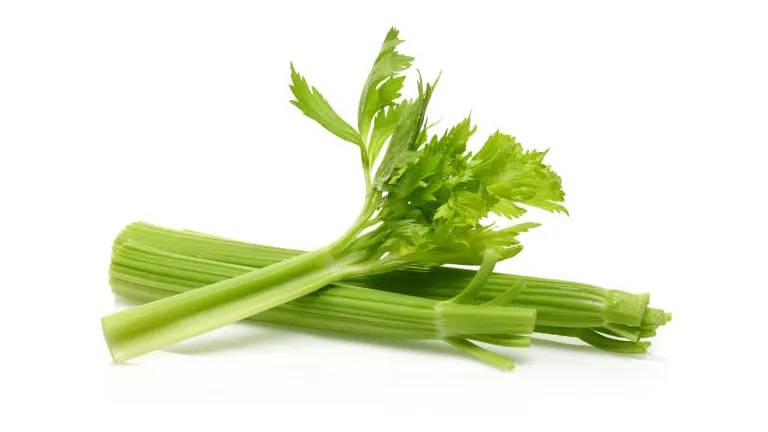
From soil preparation to pest management, we’ll ensure you have all the tools needed to make your celery plants thrive. Join us as we delve into the essential steps to produce vibrant and healthy celery stalks.
Table of Contents on How to Grow and Care for Celery
- Understanding Celery Nutrients
- Choosing the Right Variety
- Preparing the Soil
- Planting Techniques
- Watering and Nutritional Needs
- Managing Pests and Diseases
- Training and Pruning Techniques
- Stalking and Blenching Techniques
- Harvesting and Post-Harvest Care
- Troubleshooting Common Problems
- Conclusion
- FAQs
Understanding Celery Nutrients
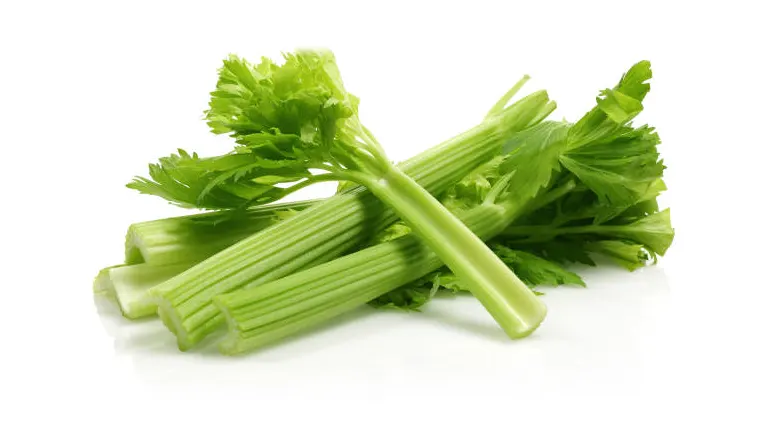
Celery, scientifically known as Apium graveolens, is often understated in its culinary versatility and nutritional benefits. Primarily composed of water, approximately 95%, celery is low in calories but dense in nutritional value, making it an ideal component for weight management and hydration strategies.
Nutritional Profile
- Vitamin K: Celery is an excellent source of Vitamin K, providing about 30% of the daily recommended intake per 100 grams. Vitamin K is crucial not only for blood coagulation but also plays a significant role in bone metabolism and regulating blood calcium levels.
- Folate (Vitamin B9): With a substantial folate content, celery supports metabolic brain functions and is crucial for DNA synthesis and repair, making it vital during pregnancy for fetal development.
- Potassium: This essential mineral, found abundantly in celery, aids in fluid balance, muscle contractions, and nerve signal transmission. It helps counteract the effects of sodium, thus regulating blood pressure and heart health.
- Vitamin C: Celery provides about 5% of the daily value per 100 grams. Vitamin C is a powerful antioxidant that supports the immune system, enhances skin health, and increases iron absorption from diets.
Additional Nutrients
- Dietary Fiber: Celery contains about 1.6 grams of fiber per 100 grams. Dietary fiber helps in digestive health, aids in maintaining lower cholesterol levels, and promotes satiety.
- Antioxidants: Apart from Vitamin C, celery is rich in flavonoids like apigenin and luteolin. These compounds have anti-inflammatory, anti-viral, and anti-cancer properties, making celery a beneficial addition for chronic disease prevention.
Nutritional Table
| Nutrient | Amount per 100g | % Daily Value* | Health Benefits |
|---|---|---|---|
| Water | 95g | – | Hydration, aids in weight management |
| Calories | 16 | – | Energy provision with low caloric intake |
| Vitamin K | 29.3 µg | 30% | Blood clotting, bone health |
| Folate (B9) | 36 µg | 9% | Cell function, tissue growth |
| Potassium | 260 mg | 5% | Fluid balance, muscle contractions, nerve signals |
| Vitamin C | 3.1 mg | 5% | Antioxidant, immune support, skin health |
| Dietary Fiber | 1.6g | 6% | Digestive health, cholesterol management |
| Phthalides | 0.1 mg | – | Lowering blood pressure, vascular health |
*% Daily Values are based on a 2000 calorie diet.
Choosing the Right Variety
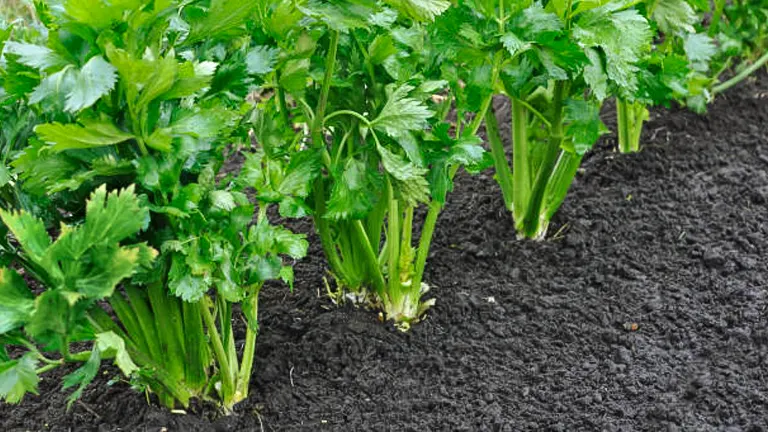
The first step in growing celery is selecting the appropriate variety that suits your climate and culinary needs. There are primarily two types of celery: self-blanching or yellow, and green. Self-blanching varieties tend to be easier to grow and have a milder taste, while green varieties are more traditional with a stronger flavor but require more care to blanch.
Types of Celery
- Self-Blanching (Yellow Celery): This type is characterized by its pale yellow stalks which naturally grow without the need for manual blanching—a process used to reduce bitterness by limiting sunlight exposure. Self-blanching celery is generally more manageable for beginners due to its mild flavor and tender texture.
- Green Celery: Known for its robust flavor, green celery is the traditional choice in many recipes. It requires blanching to achieve its characteristic mild taste and crisp texture. This variety often demands more attentive cultivation but rewards growers with its classic celery flavor.
Popular Varieties
- Tall Utah: Renowned for its long, sturdy stalks and rich flavor, ‘Tall Utah’ is a green variety that is often a gardener’s first choice for traditional celery dishes. It grows well in cooler climates and has a high tolerance to pests and diseases.
- Golden Self Blanching: Ideal for novice gardeners, this variety naturally produces paler, less stringy stalks. It’s known for its ease of growth and resistance to bolting in slightly warmer conditions than typically preferred by celery.
Considerations for Selection
When choosing a celery variety, it’s essential to consider both your local climate and culinary needs:
- Climate Adaptation: Celery generally prefers a cool climate with temperatures between 59 to 70°F (15 to 21°C). For warmer regions, select heat-tolerant varieties that can endure short periods of higher temperatures without bolting.
- Growing Season: Celery requires a prolonged growing season—typically 130 to 140 days from seeding to harvest. Ensure your growing season aligns with these needs.
Unique Varieties for Specialized Needs
For those looking to explore beyond the common types, there are unique varieties such as:
- Pink Plume: A distinctive variety with a slight pink hue to the stalks, offering a visually appealing twist along with a slightly sweeter taste.
- Peppermint Stick: Featuring streaks of red and white, this variety not only adds color to your garden but also provides a refreshing twist to the traditional celery flavor.
Varietal Comparison Table
The following table provides a detailed comparison of popular celery varieties, helping you make an informed decision based on your specific conditions and preferences:
| Variety | Type | Flavor Profile | Climate Adaptation | Growth Duration | Special Features |
|---|---|---|---|---|---|
| Tall Utah | Green | Strong, classic | Cool | 130-140 days | High pest resistance, sturdy stalks |
| Golden Self Blanching | Yellow | Mild, tender | Cool to mild | 130-140 days | Easy to grow, less stringy |
| Pink Plume | Hybrid (Green) | Sweet | Cool | 130-140 days | Aesthetic appeal, unique taste |
| Peppermint Stick | Hybrid (Green) | Mild, refreshing | Cool | 130-140 days | Visually striking, flavorful |
Preparing the Soil
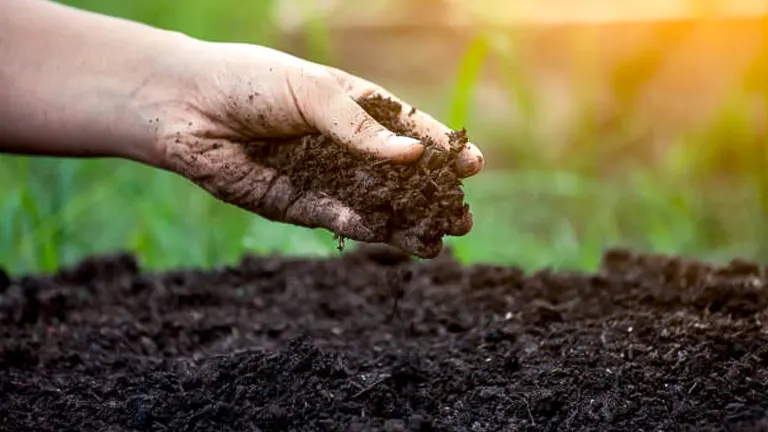
The success of growing celery begins with optimal soil preparation. Celery demands nutrient-rich soil with consistent moisture and effective drainage. Here’s a detailed guide to preparing your soil to foster healthy celery growth.
Soil Composition and Structure
Celery thrives in loamy soil that combines sand, silt, and a generous amount of organic matter. This type of soil ensures a balance between moisture retention and drainage, which is critical for celery’s root health. Enhance the soil structure by:
- Incorporating Organic Matter: Amend the soil with well-rotted manure or rich compost at least 4-6 inches deep. This practice not only improves soil fertility but also enhances its water-holding capacity, essential for celery’s high moisture needs.
- Deep Tillage: Work the soil to a depth of 12-15 inches. This deep cultivation helps break up compact layers, facilitating better root penetration and water drainage.
pH Adjustment and Nutrient Optimization
Celery prefers a slightly acidic to neutral pH, ideally between 6.0 and 7.0. Accurate soil pH is crucial as it affects nutrient availability.
- Testing Soil pH: Use a soil testing kit to determine the current pH level. This initial step is critical to tailor the pH adjustments accurately.
- Adjusting pH Levels:
- If the soil is too acidic (below 6.0), apply garden lime to increase the pH.
- For alkaline soils (above 7.0), incorporate elemental sulfur to lower the pH.
Enhancing Nutrient Content
Celery is a heavy feeder, requiring a steady supply of nutrients throughout its growth cycle.
- Nitrogen: Ensure a steady supply of nitrogen for vigorous leaf growth. Incorporate a balanced, slow-release fertilizer that includes nitrogen, phosphorus, and potassium.
- Calcium and Magnesium: These nutrients are vital for celery’s cellular development and overall vigor. Adding gypsum can improve calcium levels without altering soil pH, while Epsom salts can be used to boost magnesium content.
Drainage Solutions
Proper drainage is essential to prevent waterlogging and subsequent root diseases.
- Raised Beds: If the natural soil drainage is poor, consider constructing raised beds. This not only improves drainage but also makes it easier to control soil quality and moisture levels.
- Perlite or Vermiculite: Adding perlite or vermiculite can enhance soil aeration and drainage, beneficial for root health and disease prevention.
Soil Preparation Table
To provide clarity and precise guidance, below is a table summarizing the key steps and considerations in soil preparation for celery:
| Preparation Step | Description | Benefits |
|---|---|---|
| Organic Matter Addition | Integrate compost or manure deeply into soil. | Enhances fertility and moisture retention. |
| Deep Tillage | Cultivate soil to 12-15 inches. | Improves root penetration and drainage. |
| pH Adjustment | Test and adjust pH to between 6.0 and 7.0. | Optimizes nutrient availability. |
| Nutrient Enhancement | Add balanced fertilizers and specific minerals | Supports robust growth and health. |
| Drainage Improvement | Use raised beds or add perlite/vermiculite. | Prevents waterlogging and root diseases. |
Planting Techniques

Successful celery cultivation begins with mastering the planting techniques. Whether starting from seeds or transplanting seedlings, understanding the specific requirements of celery can significantly influence the quality and yield of your crop. Below, we provide a comprehensive guide to planting celery, along with a scientific analysis to cater to an audience seeking in-depth horticultural knowledge.
Starting Seeds Indoors
Celery seeds have a slow germination rate and require careful handling:
- Timing: Start the seeds indoors approximately 10-12 weeks before the last expected frost date. This early start is crucial as celery requires a long growing season and is sensitive to frost.
- Soil and Temperature Conditions: Use a sterile, fine seed starting mix to avoid disease. The ideal temperature for germination is around 70°F (21°C). Employ a heat mat if necessary to maintain consistent soil temperature.
- Light Requirement: Celery seeds require light to germinate. Sow them at a shallow depth of about 1/8 inch and ensure they are not covered too heavily. Use a thin layer of vermiculite to lightly cover the seeds, which allows light penetration and retains adequate moisture.
Transplanting Seedlings
Transplanting is a delicate phase in celery cultivation:
- Seedling Development: Wait until the seedlings are about 5 inches tall and have at least 3-4 true leaves. This indicates that they are robust enough to withstand the transplant.
- Hardening Off: Gradually acclimate the seedlings to outdoor conditions over a period of 7-10 days. Start by exposing them to outside conditions for a few hours each day, gradually increasing the duration. This process reduces transplant shock.
Planting and Spacing in the Garden
Proper spacing is key to ensuring healthy growth and optimal yield:
- Spacing for Density: For medium-density planting, space the celery plants about 10 inches apart. For high-density planting, where space may be limited, space them 6-8 inches apart. Ensure row spacing of 18-24 inches to facilitate good air circulation and ease of maintenance.
- Planting Depth: Since celery seeds need light to germinate, plant them at a shallow depth. Covering the seeds with a fine layer of soil or compost should be minimal.
Celery Planting Parameters
This table provides detailed planting parameters with scientific data to help gardeners achieve the best results:
| Parameter | Description | Details | Benefits |
|---|---|---|---|
| Germination Temp | Optimal soil temperature for germination | 70°F (21°C) | Enhances germination rate |
| Sowing Depth | Depth at which seeds are planted | 1/8 inch | Ensures light exposure, vital for germination |
| Seedling Height | Height at which seedlings are transplanted | 5 inches | Indicates readiness for transplant |
| Hardening Off Period | Duration to acclimate seedlings to outdoors | 7-10 days | Reduces transplant shock |
| Plant Spacing (Medium Density) | Distance between plants in medium setup | 10 inches | Optimal for growth and access |
| Plant Spacing (High Density) | Distance between plants in high setup | 6-8 inches | Maximizes space utilization |
| Row Spacing | Distance between rows | 18-24 inches | Allows for air circulation and maintenance |
Watering and Nutritional Needs
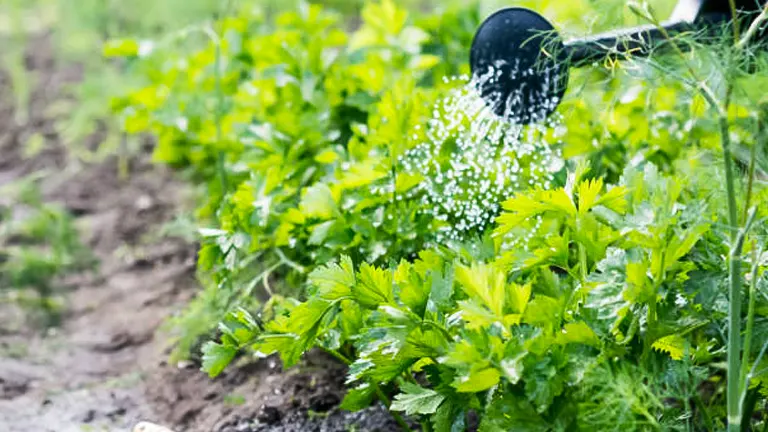
Celery, with its shallow root system and high water content, demands meticulous care in watering and fertilization to produce crisp, flavorful stalks. This section delves into the specifics of these requirements, incorporating advanced horticultural practices and scientific insights to optimize growth and health.
Watering Requirements
Celery’s need for constant moisture is crucial due to its composition and root structure:
- Deep Watering Technique: It’s essential to water celery deeply but gently, ensuring that the moisture reaches the root zone. Aim to provide 1 to 1.5 inches of water per week through slow, steady irrigation. This approach helps prevent surface water wastage and ensures the roots are sufficiently hydrated.
- Adjusting to Weather Conditions: Increase watering frequency during periods of high heat or low rainfall. Monitoring soil moisture levels can prevent both overwatering and underwatering, protecting the plant from stress.
- Mulching: Applying a layer of organic mulch around the plants can conserve moisture, reduce weed competition, and maintain an even soil temperature. Suitable mulching materials include straw, shredded leaves, or finely ground bark.
Nutritional Requirements
As a heavy feeder, celery requires a robust feeding regimen to support its rapid growth and high nutrient demand:
- Balanced Fertilization: Utilize a slow-release fertilizer with a balanced N-P-K ratio (nitrogen, phosphorus, potassium) every four to six weeks. This consistent nutrient supply is vital for the development of strong, healthy celery plants.
- Organic Side-Dressing: Complement synthetic fertilizers with organic compost. Side-dressing celery with compost can enhance soil structure, increase nutrient content, and support microbial health, all of which contribute to more robust plant growth.
- Micronutrients: Incorporating a micronutrient blend or using foliar sprays can address specific deficiencies. Elements like calcium and magnesium are critical for celery, aiding in cellular integrity and overall plant vigor.
Special Considerations
- Soil pH Influence: Celery prefers a slightly acidic to neutral soil pH (6.0 to 7.0). Since pH can affect nutrient availability, regular soil testing and adjustments are recommended to maintain optimal growing conditions.
Watering and Nutritional Schedule for Celery
This table provides detailed guidance on watering and feeding celery, based on scientific data and best practices:
| Aspect | Details | Frequency/Timing | Benefits |
|---|---|---|---|
| Water Depth | 1 to 1.5 inches per session | Weekly or more in hot weather | Ensures deep root hydration |
| Mulch Type | Organic (straw, leaves, bark) | Apply once at planting | Conserves moisture, regulates soil temperature |
| Fertilizer Type | Balanced slow-release | Every 4-6 weeks | Sustains growth with essential nutrients |
| Compost Side-Dressing | Organic compost | Mid-season refresh | Enhances soil health, adds nutrients |
| Micronutrients | Calcium, magnesium, etc. | As needed based on soil tests | Supports cellular structure and plant health |
| pH Testing | Soil pH level | Before planting and seasonally | Optimizes nutrient uptake and plant health |
Managing Pests and Diseases
Effective management of pests and diseases is crucial for maintaining the health and productivity of celery crops. Given celery’s susceptibility to various threats, a proactive and informed approach can greatly mitigate potential damage. This enhanced section provides detailed strategies and innovative solutions, along with scientific insights, to address these challenges in celery cultivation.
Pest Management
Celery is targeted by several pests that can impact its growth and quality:
- Aphids and Whiteflies: These pests can cause significant damage by sucking sap and transmitting diseases. Regular monitoring is essential. For minor infestations, a strong jet of water can dislodge these pests from the plants. For more persistent problems, organic insecticidal soaps or neem oil applications can be effective. Neem oil acts as both a repellent and a growth regulator, disrupting the life cycle of pests.
- Slugs: These are common in moist, cool environments. Use barrier methods such as copper tape around plant bases, or employ diatomaceous earth, which causes physical damage to the slugs as they cross over the substance.
Disease Management
Celery is prone to several fungal diseases that thrive in damp conditions:
- Celery Leaf Spot: This disease manifests as small, dark spots on the leaves which can coalesce and kill large areas of tissue. Preventive measures include ensuring good air circulation through proper plant spacing and avoiding overhead watering to keep foliage dry.
- Pink Rot: This fungal disease affects the roots and lower stems, leading to plant decline. It is crucial to ensure well-drained soil and use crop rotation to prevent its occurrence.
- Fusarium Wilt: A soil-borne fungal disease that causes yellowing and wilting of leaves. Implementing a crop rotation plan and using resistant varieties can help manage this disease effectively.
Innovative and Scientific Approaches
- Biological Control: Introducing beneficial insects, such as ladybugs and lacewings, can naturally reduce pest populations by predation.
- Integrated Pest Management (IPM): Implementing an IPM strategy involves monitoring plants regularly, identifying pests and diseases early, and choosing the least invasive control methods. This approach minimizes pesticide use and promotes a healthier crop environment.
Training and Pruning Techniques
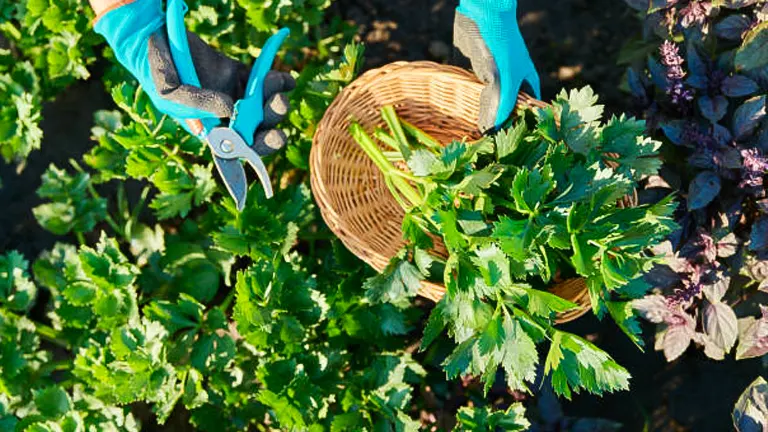
Proper training and pruning are critical techniques that significantly enhance the health and productivity of celery plants. These practices not only support the structural integrity of the plants but also optimize their growth conditions. Below, we delve into advanced methods for training and pruning celery, incorporating scientific insights and precision to cater to an audience that appreciates detailed horticultural knowledge.
Training Celery Plants
Training involves techniques to support and guide the physical growth of celery plants:
- Support Structures: In windy areas or gardens where celery stalks tend to lean or fall, providing support is crucial. Use small stakes or plant supports to keep celery upright. This prevents bending and breaking, which can stress the plant and reduce its yield.
- Tying Techniques: When tying celery to stakes, use soft, flexible materials like garden twine or strips of cloth. Tie loosely to allow for growth and prevent damage to the stalks. The tying should be firm enough to support the plant but flexible enough to not cut into the growing stalks.
Pruning Celery Plants
Pruning is essential for maintaining plant health and promoting vigorous growth:
- Regular Inspection and Removal: Check plants regularly for yellowed, damaged, or diseased leaves. Remove these promptly using clean, sharp pruning shears. This helps prevent the spread of disease and redirects the plant’s energy towards producing new, healthy growth.
- Enhancing Air Circulation: By selectively removing some of the inner leaves and stalks, you can improve air circulation around and within the plant. This practice is particularly important in humid climates, as it reduces the risk of fungal infections like leaf spot or blight.
- Disease Management: Implementing a rigorous pruning schedule helps in early detection and removal of potential disease vectors, minimizing the risk of widespread infection.
Special Considerations
- Blanching: For certain varieties of celery, especially green types, blanching (covering the stalks to prevent sunlight exposure) is performed to reduce bitterness. This can be achieved by gently wrapping the stalks with paper or by mounding soil around the base of the plants.
Stalking and Blenching Techniques
Celery stalks, particularly in green varieties, can develop a strong, sometimes bitter flavor if exposed to too much sunlight. Blenching, the practice of shielding the stalks from direct sunlight, enhances their tenderness and sweetens their flavor.
- Natural blenching methods: This involves gradually mounding soil around the base of the plants as they grow, covering up to two-thirds of the stalk height. Ensure the soil is loose and not packed tightly, as this could affect the roots.
- Artificial blenching options: If manual soil mounding is not feasible, consider using paper rolls or boards to wrap or shield the celery. These materials do not retain moisture, reducing the risk of rot, and they provide an effective barrier against sunlight.
Harvesting and Post-Harvest Care
Knowing when and how to harvest celery will significantly impact the quality and shelf life of your produce.
- Timing your harvest: Celery is typically ready for harvest when the stalks reach a usable size and are firm to the touch, usually about 85 to 120 days after planting, depending on the variety. The stalks should be at least 12 inches tall.
- Harvesting technique: Cut the celery at the soil line using a sharp knife, ensuring that you do not disturb the roots of nearby plants. For a continuous harvest, you can also opt to remove outer stalks individually, allowing the inner stalks to continue growing.
- Post-harvest handling: After harvesting, remove any leafy tops, and wash the stalks thoroughly. Celery can be stored in the refrigerator in a plastic bag for up to two weeks. For longer storage, consider blanching and freezing the stalks.
Troubleshooting Common Problems
Even with meticulous care, celery growers can encounter a few common issues. Here’s how to manage them:
- Bolting: Celery can bolt, or go to seed, in response to unexpected cold spells or excessively long hot periods. To minimize this risk, choose bolt-resistant varieties and ensure consistent soil moisture.
- Cracked stalks: This can occur due to uneven watering. To prevent cracking, maintain a regular watering schedule and ensure the soil is consistently moist.
- Pithiness: Over-mature celery can become hollow or pithy. Regular monitoring and timely harvesting will help maintain the quality of the stalks.
Related Post
- How to Build a Barn: A Step-by-Step Guide for Beginners
- How to Build a Sustainable Compost Bin: Easy and Eco-Friendly DIY
- How to Fertilize Bougainvillea: A Complete Guide for Stunning Blooms
- How to Fertilize Apple Trees: Essential Tips for a Bountiful Harvest
- How to Fertilize Lemon Trees: Secrets for Thriving Citrus
- How to Fertilize Avocado Tree: A Step-by-Step Guide for Lush Growth
- 10 Best Bow Saws to Buy in 2024: Top Picks for the Money
- Best Miter Saw For Beginners
- Top 10 Pruning Saws to Buy in 2024: Best for the Money
- 7 Best Pocket Chainsaw
Conclusion
Growing celery in your garden can be a deeply satisfying endeavor, yielding a fresh supply of this versatile and nutritious vegetable. By following the expert tips outlined in this guide—from selecting the right variety and preparing the soil to implementing effective planting, watering, and care strategies—you can enjoy lush, healthy celery stalks.
FAQs
- What is the best time of year to plant celery?
Celery should be planted in early spring, after the last frost, or in late summer for a fall harvest. The goal is to avoid the hottest part of the summer, as celery thrives in cooler temperatures. - How can I tell if my garden soil is suitable for growing celery?
Celery needs rich, well-drained soil with a pH between 6.0 and 7.0. You can test your soil’s pH with a home testing kit. If your soil is too sandy or too clay-heavy, amend it with compost to improve its structure and fertility. - Does celery require full sun or can it grow in partial shade?
Celery grows best in full sun, but it can tolerate partial shade, especially in hotter climates. Ideally, it should receive at least 6 hours of sunlight per day. - How often should I water my celery plants?
Celery requires consistent moisture to develop its characteristic crisp stalks. Water deeply at least once a week, providing enough water to soak the soil thoroughly. In very hot or dry conditions, increase watering to twice or even three times a week. - What are the signs of over-fertilizing celery?
Signs include rapid leaf growth with few or no stalks, yellowing of leaves, and salt buildup in the soil. It’s essential to use a balanced, slow-release fertilizer and follow the recommended application rates. - How do I prevent celery from becoming too stringy?
Stringiness in celery is often due to insufficient water or nutrients. Ensure your plants are well-watered and well-fed. Blenching, or shielding the stalks from direct sunlight by mounding soil around them, can also help reduce stringiness. - Can celery be grown in containers?
Yes, celery can be successfully grown in containers. Choose a container that is at least 12 inches deep and wide enough to accommodate the plant’s spread. Ensure it has good drainage and use a high-quality potting mix. - What should I do if my celery plants start to flower prematurely?
Premature flowering, or bolting, is often triggered by stress, such as extreme temperatures or insufficient watering. Once a celery plant bolts, its stalks become bitter and tough. To prevent bolting, keep the plants well-watered, especially during hot spells, and consider using a mulch to help keep the soil cool and moist.
With these expert tips in hand, you’re now equipped to grow and nurture celery that’s as healthy as it is delicious. Happy gardening, and enjoy the crisp, fresh taste of your home-grown celery!

Kristine Moore
Forestry AuthorI'm Kristine Moore, a seasoned garden landscaping professional with over 30 years of experience. My extensive career has been dedicated to transforming outdoor spaces into stunning, sustainable landscapes. With a deep understanding of horticulture, design principles, and environmental stewardship, I have become a respected figure in the field, known for creating harmonious, visually appealing, and eco-friendly gardens. My commitment to excellence and continuous learning in landscaping trends and techniques has solidified my reputation as an expert in garden design and implementation.













Leave your comment